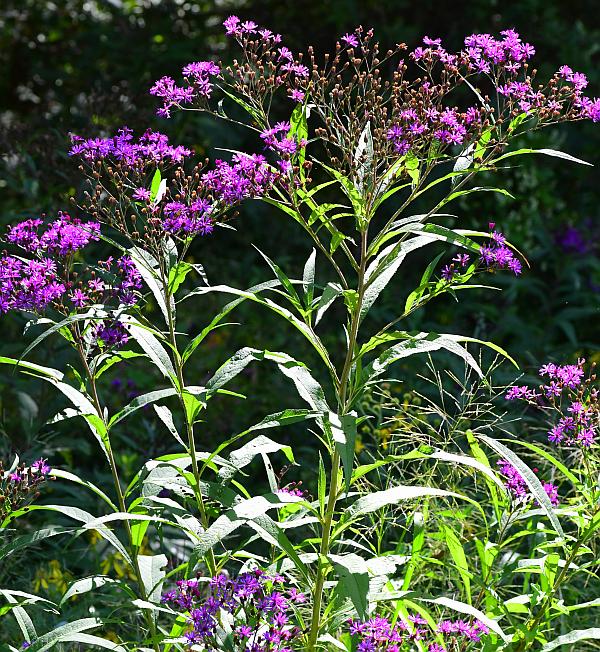Vernonia gigantea (Walter) Trel. ex Branner & Coville
Tall Ironweed

Native
CC = 6
CW = 0
MOC = 47
© SRTurner
Vernonia gigantea (Walter) Trel. ex Branner & CovilleTall Ironweed | |
 |
Native CC = 6 CW = 0 MOC = 47 |
© SRTurner |
|
Family - Asteraceae/Vernonieae Habit - Perennial forb, with a stout, often short-rhizomatous rootstock. Stems - Erect, to 2.5 m, single or multiple, branched toward the tip, minutely hairy, sometimes becoming nearly glabrous toward the base.
Leaves - Alternate, simple, sessile or short-petiolate. Blades 6-30 cm long, lanceolate to oblong-lanceolate and narrowly ovate, occasionally elliptic-oblanceolate, tapered at both ends, the margins sharply toothed, the upper surface glabrous or occasionally somewhat roughened toward the margins, the undersurface minutely hairy, especially along the veins, occasionally sparse, longer hairs also present along the veins.
Inflorescences - Terminal, irregularly branched panicles of heads.
Heads - Discoid, with 13-30 florets. Involucre 3-7 mm long, short-cylindrical to somewhat hemispherical or bell-shaped, the bracts 2.0-5.5 mm long, ovate to oblong-ovate or oblong-lanceolate, rounded or broadly angled to a bluntly pointed tip, the innermost bracts rarely abruptly tapered to a minute, sharp point, appressed, glabrous or sparsely and minutely hairy, the margins occasionally also minutely hairy, purplish-tinged to uniformly dark purple, the midvein not keeled or only slightly so toward the tip.
Florets - Ray florets absent. Disk floret corollas 9-11 mm long, purple. Pappus dimorphic, tan to brownish purple, the inner bristles 5-6 mm long, the outer scales 0.2-0.8 mm long.
Fruits - Achenes 2.8-3.5 mm long, narrowly ribbed, usually hairy. Flowering - August - October. Habitat - Streambanks, pond margins, bottomland forests, swamps, fens, fields, pastures, ditches, and roadsides. Origin - Native to the U.S. Lookalikes - V. missurica, V. baldwinii. Other info. - This species can be found scattered throughout much of Missouri but is uncommon to absent in the southwestern region of the state. It is distributed broadly within the U.S. Midwest. Although the ironweeds (genus Vernonia) are easily recognized by their heads of purple disk flowers, identification to species requires attention to detail. In V. gigantea, the involucral bracts are strongly appressed, and the number of florets in each head is relatively small, usually well under 30. The stems and leaves are also less pubescent than those of the close lookalike V. missurica. Under ideal conditions the plant can become very tall, towering over the heads of people and other species of ironweed. However, plants do not always achieve this stature, so height is not a reliable character for identification. Species of Vernonia are notorious for facile crossing, leading to intermediate forms which are difficult to identify. V. gigantea is somewhat less prone to this than Missouri's other species of ironweed.
Photographs taken off Lee Rd 54, Auburn, AL., 10-7-04 (DETentaglia); also at Onondaga Cave State Park, Crawford County, MO, 9-5-2011 and 9-25-2014, and at Woodson K. Woods Conservation Area, Crawford County, MO, 9-17-2021 (SRTurner). |